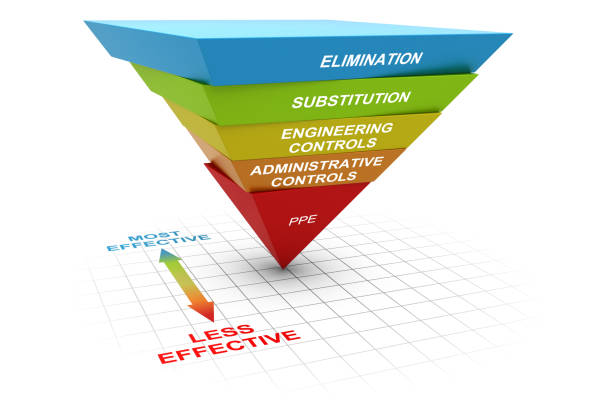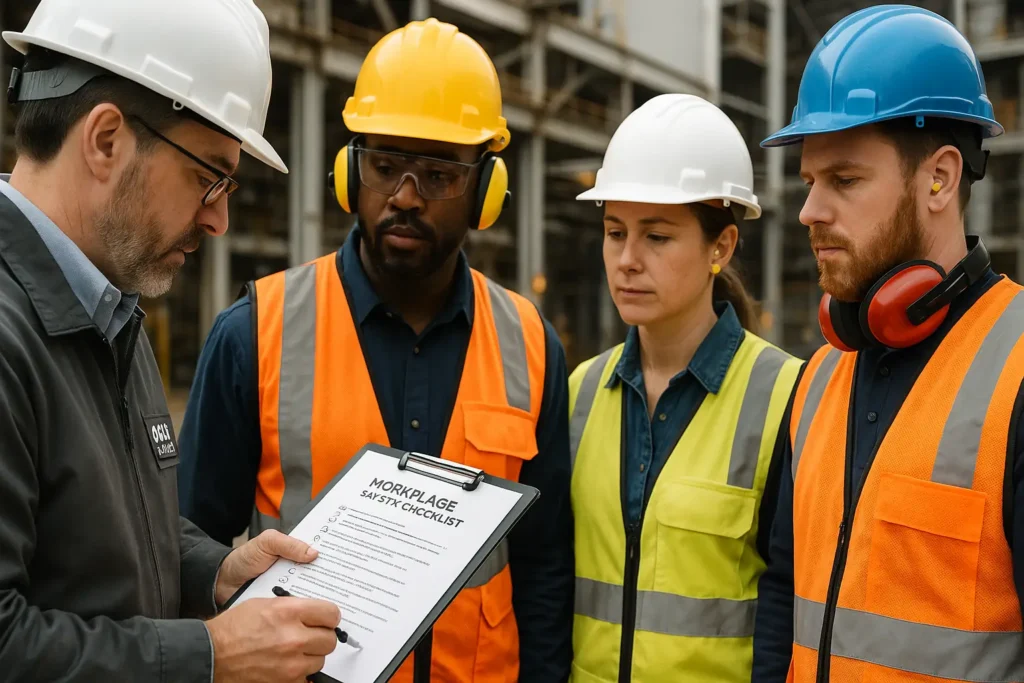Noise Hazards at Work: Risks, Prevention & OSHA Guidelines
⚠️ Occupational Noise Hazards
Noise hazards are historically associated with loud industries such as shipbuilding, mining, railroad work, welding, and construction. There’s a limit to the amount of acoustic energy an employee’s auditory system can receive before it becomes a health risk.
In occupational health and safety, occupational noise refers to any noise created by machinery on worksites that poses a danger to workers and can cause long-term, irreversible hearing damage.
Because of its intensity and repetitive nature, occupational noise is no less hazardous than faulty scaffolding. Unfortunately, many employers and contractors fail to address this danger adequately.
📊 Annual Exposure
The CDC estimates that 22 million workers are exposed to potentially harmful noise each year.
Source: CDC
🏗️ High-Risk Environments
Noise is especially damaging in confined spaces but remains a threat in open areas where machinery operates.
🔊 Primary Sources of Noise Hazards in the Workplace
Noise is a prevalent issue that can be found in almost any workplace. In industries such as entertainment, manufacturing, agriculture, shipbuilding, textiles, mining and quarrying, food and drink, woodworking, metalworking, and construction, it is the most common health danger.
Various factors, including excessive loud exposure, can cause hearing loss. Hearing loss can also be caused by some chemical agents known as ototoxic substances and drugs. Over 200 chemical compounds have been recognized as having the potential to cause hearing loss, either temporarily or permanently. Noise-induced hearing loss may be exacerbated by exposure to such substances.
🏭 High-Risk Industries
Entertainment, manufacturing, agriculture, shipbuilding, textiles, mining and quarrying, food and drink, woodworking, metalworking, and construction are the industries most affected by workplace noise hazards.
🧪 Chemical & Drug Risks
Over 200 ototoxic substances and drugs can cause temporary or permanent hearing loss, with noise-induced hearing loss becoming worse when combined with such exposures.
📋 Types of Noise Hazards
Here’s a noise hazards list every business owner should know about.
- 1. Loud Loud music,
- 2. Heavy machinery,
- 3. Workplace transportation
- 4. Circular saws and cutter heads are examples of electrical tools.
- 5. Lines of production
- 6. Drills, grinders, and riveting guns are examples of pneumatic tools.
- 7. Generators and electric motor
- 8. Metal fabrication is an example of an engineering process.
- 9. Ventilation equipment must run continually in plant rooms.
🩺 Health Effects of Noise Pollution
Individuals exposed to high levels of noise in the workplace may have various adverse health effects. These health problems can be produced by a single exposure to extremely loud noise or sustained exposure to high noise levels.
Noise-induced hearing loss is the most common occupational affliction in Europe. At least half of the time, they are at work; 20% of Europe’s workers must raise their voices to be heard, and 7% have hearing problems. In 2000, 29% of EU15 workers and 35% of new member state workers said they were exposed to high-level noise at least a quarter of the time and 11% all the time.
📊 Europe Statistics
- 20% of workers must raise their voices to be heard
- 7% have hearing problems
- 29% of EU15 workers exposed to high noise a quarter of the time
- 35% of new member state workers exposed a quarter of the time
- 11% exposed to high noise all the time
🇬🇧 United Kingdom Statistics
- 10 million people (1 in 6) have some degree of hearing impairment or deafness
- Over 1 million workers exposed to hearing-endangering noise levels
- 17% suffer from hearing loss, tinnitus, or other hearing-related issues
🔇 How to Reduce Noise Hazards in the Workplace
Once you’ve determined that noise pollution is possible in your workplace, the next step is to address the issue. Companies can take steps to promote a safer working environment for their employees by reducing their exposure to noise pollution.

📑 Using Hierarchy Of Controls To Reduce Noise Hazards
There are numerous options for limiting your occupational noise exposure. A guideline for reducing harmful noise is the hierarchy of controls. First, the business can eliminate the source of the noise. If the noise source cannot be eradicated, the organization must seek alternate techniques to lessen the noise. Acoustic quieting is the term for this technique.
1️⃣ Elimination
Remove the noise source entirely if possible to eliminate exposure risks.
2️⃣ Acoustic Quieting
Dampen vibrations in machinery or isolate it from workers to reduce the noise signal reaching the ear.
3️⃣ Administrative Control
Limit the duration of worker exposure by rotating shifts or moving workers away from noise zones.
4️⃣ Personal Protective Equipment
Use earplugs or earmuffs to reduce noise to a safe level.
📋 Noise Hazards and Control Measures
Here are simple precautions for mitigating the risk associated with consistent loud noises.
- 1. Loud Changing the equipment
- 2. Place equipment in a separate, soundproof enclosure or a different, isolated place.
- 3. Employees should receive personal hearing protection, such as earplugs or earmuffs.
- 4. Allow staff to work in the office’s quiet zones.
- 5. Run noisy equipment early in the morning or late at night.
- 6. Allow acoustic professionals to examine your situation and provide you with various options.
Keep an eye on staff sick days and productivity drops. Understand your OSHA adherence responsibilities and do your utmost to resolve noise issues. Develop a hearing conservation program by taking the necessary steps (HCP). A healthy work environment equals a healthy bottom line.
Excessive noise exposure can be mitigated by using noise controls. These controls should prevent hazardous exposure to the point where the risk of hearing loss is eliminated or reduced. Hearing loss is minimized, communication is improved, and noise-related irritation is reduced when decibel levels are reduced by even a few dB. There are numerous methods for controlling and reducing noise exposure in the workplace.
🔧 1. Control the Noise Sources
Engineering measures that limit sound exposure levels are available and technologically viable for most noise sources. Engineers repair or replace equipment or make relevant physical changes at the noise source or along the transmission channel to reduce the noise level at the worker’s ear.
In some cases, a relatively simple engineering noise control solution minimizes the noise hazard to the point where additional OSHA Noise standard requirements—such as audiometric testing (hearing tests), hearing conservation programs, and provision of hearing protectors—aren’t required.
The following are some examples of low-cost, adequate engineering controls:
- 1. Choose low-noise tools and gear (for example, NASA’s Quiet Roadmap).
- 2. Machinery and equipment should be maintained and lubricated regularly (oil bearings).
- 3. Put a barrier between the source of the noise and the employee (sound walls or curtains).
- 4. Isolate or enclose the source of the noise.
Changes in the workplace that decrease or eliminate worker noise exposure are known as administrative controls. These include adjustments to work practices and schedules to reduce exposure.
📏 2. Maintain a Sound and Distance Balance
Controlling noise exposure by distance is a common and effective administrative control that is both easy and economical. This method is suitable when workers are present but not directly operating the noisy equipment. Increasing the distance between the noise source and the worker reduces exposure levels. In open space, noise decreases by six dBA for every doubling of the distance from the source.
- 1. Using noisy machines during shifts when there are fewer people around.
- 2. Keeping the time a person spends near a noisy source to a minimum.
- 3. Providing quiet locations where workers can escape dangerous noise sources (e.g., build a soundproof chamber where workers’ hearing can recover – depending on their noise level and duration of exposure, as well as time spent in the quiet area).
- 4. Worker presence should be limited to a safe distance from noisy equipment.
🎧 3. Use Ear Muffs to Safeguard Workers
Hearing protection devices (HPDs), such as earmuffs and earplugs, are a less desirable but acceptable option for controlling noise exposures. They are typically used while engineering or administrative controls are being implemented, when such controls are not feasible, or when worker hearing tests reveal significant hearing damage.
Employers in the general industry must implement an effective noise and hearing conservation program whenever worker noise exposure is equal to or greater than 85 dBA for an 8-hour exposure. In construction, the threshold is 90 dBA for an 8-hour exposure. The aim is to prevent initial occupational hearing loss, preserve remaining hearing, and equip workers with the necessary information and devices.
Personal noise monitoring, which detects which employees are in danger from hazardous noise levels, is included in workplace noise sampling.
📋 Elements of a Successful Hearing Conservation Program
- 1. Notifying workers at risk of being exposed to dangerous noise levels about the results of their noise monitoring.
- 2. Allowing impacted workers or their authorized representatives to observe any noise measurements being taken.
- 3. Maintaining an audiometric testing program (hearing tests) for workers is a professional assessment of the health impacts of noise on individual workers’ hearing.
- 4. After completing baseline (initial) and yearly audiometric testing, complete hearing protection follow-up procedures are implemented for workers who indicate a loss of hearing (standard threshold shift).
- 5. Proper hearing protection selection is based on individual fit and manufacturer quality testing, which indicates the likely level of protection provided to an adequately trained wearer.
- 6. Examine the hearing protector’s attenuation and effectiveness concerning the noise level in your job.
- 7. Workers should receive training and information to ensure they know the dangers of excessive noise exposure and how to use the protective equipment provided correctly.
- 8. Information management and staff access to monitoring and noise assessment records.
⚠️ Health impact: Temporary hearing impairment occurs when constant exposure to intense noise leads to ear fatigue.
✅ Conclusion
It’s the responsibility of safety leaders to create an environment where noise hazards don’t end up causing damage to workers. Getting enrolled in the OSHA 10-hour construction course can help workers identify the dangers of loud noise at workplaces.
However, safety managers should consider enrolling in the more comprehensive OSHA 30-hour construction course to learn how to protect themselves and their teams from noise hazards.
A safer workplace begins with informed leaders and trained workers.
Related Posts

Training on a Budget? Find OSHA Training at a Low Price

OSHA Winter Safety Tips for 2025: Protect Outdoor Workers


